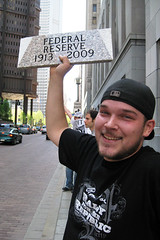| Federal Reserve: 1913-2009 (Photo credit: r0b0r0b) |
U.S. retail sales notched a brisk 1.1 percent gain last month, data released earlier on Monday showed, as Americans bought more goods in an upbeat sign of economic activity. That news, which promised faster economic growth ahead, followed a sharp drop in unemployment last month to 7.8 percent, which brought the rate below 8 percent for the first time in 3-1/2 years, although it remains high by historic standards.
Dudley also told the National Association for Business Economics at an event in New York that fears the Fed’s extraordinary stimulus steps will cause financial asset bubbles or inflation were misplaced. He said the Fed’s ability to adjust the interest it pays banks to park funds there – called interest on excess reserves, or IOER – “means we can keep inflation in check regardless of the size of our balance sheet.”
2ND QTR SLOWDOWN TRANSITORY – LACKER
That sanguine view of the inflation risk posed by the Fed’s actions was disputed by Richmond Federal Reserve President Jeffrey Lacker, who dissented against the policy easing last month and voiced concern about the impact on price stability.“The behavior of inflation is fundamentally attributable to the actions of the central bank, while growth and labor market conditions are affected by a wide variety of factors,” he told a business conference in Roanoke, Virginia.The Fed last month announced a new open-ended bond buying plan of $40 billion in mortgage debt purchases per month until it sees a significant improvement in labor market conditions. This follows purchases of $2.3 trillion since interest rates were lowered to near-zero in late 2008. ... Continue to read.


No comments:
Post a Comment